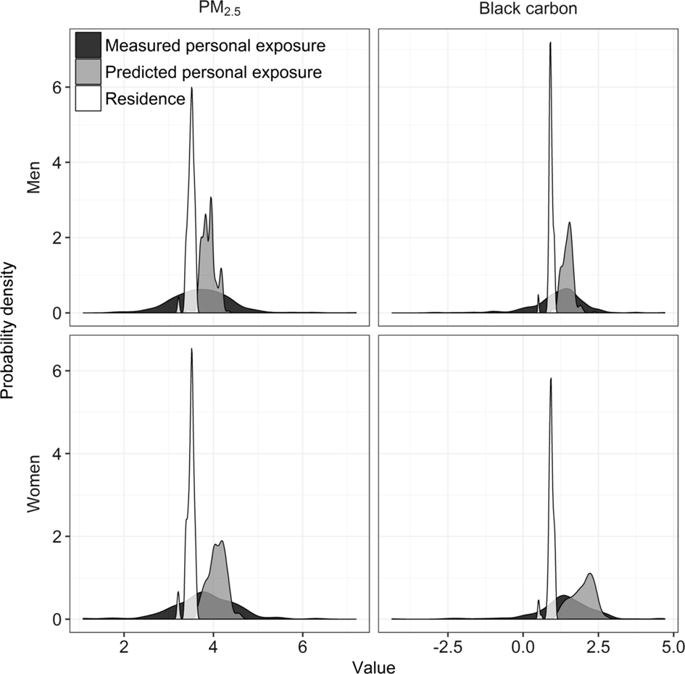Journal of Exposure Science and Environmental Epidemiology ( IF 4.1 ) Pub Date : 2019-07-01 , DOI: 10.1038/s41370-019-0150-5 Margaux Sanchez 1, 2, 3 , Carles Milà 1, 2, 3 , V Sreekanth 4 , Kalpana Balakrishnan 5 , Sankar Sambandam 5 , Mark Nieuwenhuijsen 1, 2, 3 , Sanjay Kinra 6 , Julian D Marshall 4 , Cathryn Tonne 1, 2, 3

|
Scalable exposure assessment approaches that capture personal exposure to particles for purposes of epidemiology are currently limited, but valuable, particularly in low-/middle-income countries where sources of personal exposure are often distinct from those of ambient concentrations. We measured 2 × 24-h integrated personal exposure to PM2.5 and black carbon in two seasons in 402 participants living in peri-urban South India. Means (sd) of PM2.5 personal exposure were 55.1(82.8) µg/m3 for men and 58.5(58.8) µg/m3 for women; corresponding figures for black carbon were 4.6(7.0) µg/m3 and 6.1(9.6) µg/m3. Most variability in personal exposure was within participant (intra-class correlation ~20%). Personal exposure measurements were not correlated (Rspearman < 0.2) with annual ambient concentration at residence modeled by land-use regression; no subgroup with moderate or good agreement could be identified (weighted kappa ≤ 0.3 in all subgroups). We developed models to predict personal exposure in men and women separately, based on time-invariant characteristics collected at baseline (individual, household, and general time-activity) using forward stepwise model building with mixed models. Models for women included cooking activities and household socio-economic position, while models for men included smoking and occupation. Models performed moderately in terms of between-participant variance explained (38–53%) and correlations between predictions and measurements (Rspearman: 0.30–0.50). More detailed, time-varying time-activity data did not substantially improve the performance of the models. Our results demonstrate the feasibility of predicting personal exposure in support of epidemiological studies investigating long-term particulate matter exposure in settings characterized by solid fuel use and high occupational exposure to particles.
中文翻译:

印度郊区的个人暴露于颗粒物:预测因素以及与居住环境浓度的关系。
目前,为流行病学目的而捕获个人暴露于颗粒物的可扩展暴露评估方法是有限的,但很有价值,尤其是在中低收入国家,这些国家的个人暴露源通常与环境浓度不同。我们在居住在印度南部郊区的402名参与者中,在两个季节中测量了2×24小时的个人暴露于PM 2.5和黑碳的综合暴露量。男性PM 2.5个人暴露的平均值(sd)为男性55.1(82.8)µg / m 3,女性58.5(58.8)µg / m 3。黑碳的相应数字为4.6(7.0)µg / m 3和6.1(9.6)µg / m 3。个人暴露的最大变化是在参与者内(类内相关性〜20%)。个人暴露量与测量值无关(R spearman <0.2),并通过土地利用回归建模得出居住地的年度环境浓度;不能鉴定出具有中度或良好一致性的亚组(所有亚组的加权Kappa≤0.3)。我们使用正向逐步模型构建和混合模型,基于在基线(个人,家庭和一般时间活动)收集的时不变特征,开发了分别预测男性和女性个人暴露的模型。妇女的模型包括烹饪活动和家庭社会经济地位,而男子的模型包括吸烟和职业。在参与者之间的方差解释(38–53%)以及预测和度量之间的相关性方面,模型表现适中(R spearman:0.30–0.50)。更详细的时变时间活动数据并没有实质性改善模型的性能。我们的结果证明了预测个人暴露以支持流行病学研究的可行性,该流行病学研究旨在调查以固体燃料使用和高职业性颗粒暴露为特征的环境中长期颗粒物暴露。











































 京公网安备 11010802027423号
京公网安备 11010802027423号